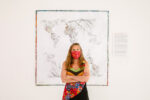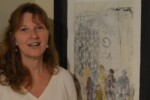The emotional history of families is intense, multilayered and often impossible to capture in mere words.
Sandra Mayo demystifies these histories and complexities in visual form as a printmaker. She specializes in genograms. Envision more nuanced family trees: These visual representations of dynamics, relationships and personal histories crystallize emotions and layers that are sometimes too deep, or too painful, for mere conversation.
“Genograms are family trees that come alive, because they not only tell you who is related to whom, but also what type of relationships exist within the people. They’re even used by therapists because, in 15 minutes, you can tell the family’s patterns,” she explains. These patterns can be straightforward, such as a history of illness, or more complicated, such as a legacy of mothers and daughters with fraught relationships.
Related
Mayo hails from Argentina, where she was active in the Jewish community: preparing girls for bat mitzvah, singing in choirs, leading Israeli folk dancing classes. She came to the United States for graduate school, focusing on education. As a student, she took a class on genograms and, as a longtime hobbyist in the arts, became transfixed.

Mayo creates the prints by interviewing family members, which requires trust and delicacy. She is skilled in both, having begun her genogram journey by focusing on individuals who endured two major social traumas: surviving the Holocaust and later experiencing the disappearance of a son or daughter during Argentina’s Dirty War (desaparecidos).
One particular subject was a Polish Holocaust survivor, Sara Rus, who made it to Buenos Aires with the help of Evita Perón.
“She didn’t know any Spanish. She spoke Russian, German, Polish, and Yiddish. She had been in three concentration camps. She was a petite lady with an amazing spirit, and after crossing into Argentina from Paraguay as an undocumented immigrant, she was caught and jailed. From jail, she wrote a letter in Polish to Evita Perón, asking for help to reach Buenos Aires. Evita translated the letter and wrote back to her in Polish, saying, ‘I’ll take you out of there.’ And after two months, she made it to the capital of Argentina,” Mayo recalls.
Sara married a fellow survivor and had two children. But 30 years later, in 1976, tragedy struck again: Argentina was consumed by warfare and military dictatorship. Her son, Daniel, became one of the desaparecidos—the thousands of people deliberately abducted by the regime during the Dirty War for being activists, intellectuals or simply viewed as political threats.
“This is a grief that you cannot mourn, because there is nobody to mourn. Even at night, she’s still waiting for the key to turn the door and for him to open the door,” Mayo recalls.

After Oct. 7, Mayo fell into an artistic abyss. It was hard to be creative, and impossible to focus.
“I was just looking at the sky and thinking: How did Sara wake up every morning? She kept going. She went through two major social traumas, and this was the pattern of her life,” Mayo says.
While Mayo had been developing her approach to genograms for some time, she resolved to create one reflecting Sara’s life. There was a complication: Genograms didn’t contain symbols for genocide. Mayo created four new symbols to reflect such torture, killing, and ideally liberation, to accurately reflect the experiences of so many.
Sara’s story wasn’t thoroughly bleak, though. Mayo asked her: What keeps you going?
“She was an amazing, resilient woman,” she says. “And for Sara, it was colors: flowers, tulips. Even her grandchildren drew tulips on the walls of her living room.”
The genogram reflects this beauty—and this brutality.

The CJP and JArts Creative Fellowship will enable Mayo to continue workshops. Soon, she’ll conduct one with kids and grandparents; another one is planned with Gann Academy.
While everyone’s genogram art is a singular reflection of their lives’ paths and pitfalls, one thing is universal.
“I use genograms as a map for my pictorial language, to work through social trauma or difficult times through art, using symbols that also bring us together,” she explains. “I can open my heart and myself when my art is out there.”
Mayo recalls a 2023 exhibition at the Argentinian consulate celebrating 40 years of democracy, where Argentinian President Alberto Fernández approached her to express thanks. The show focused on Sara’s story and the civic-military dictatorship endured by so many. After the show, an audience member approached her.
“She said: ‘You don’t understand. I’m on the other side. I’m a daughter of two military people. I never really understood what had happened until I saw the genograms on the walls,” Mayo recalls. “Art can help people change their perspectives, and it can open their minds.”
Follow Sandra Mayo on Instagram.
Sandra Mayo is part of the 2024–2025 CJP and JArts Community Creative Fellowship, a program dedicated to elevating local creators who transform Jewish life through storytelling, music and art. Now in its fifth year, the fellowship highlights diverse voices and traditions, expanding the contemporary Jewish canon with work that resonates deeply with Greater Boston’s communities. Learn more about this year’s cohort.






